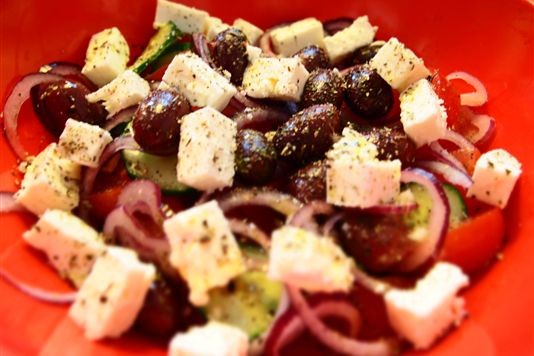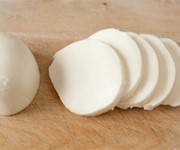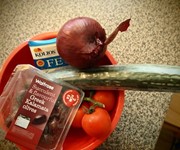Euro salads

Economic depression hasn't dragged down Europe's salad riches. These three bright European salads are a simple but luscious addition to any summer meal.
The Basics
For my third and final piece about salads, I return to my home continent and the birthplace of western culture: Europe. These three salads all deserve to be done well and, crucially, with the best quality ingredients available.
While in the Middle East they love masses of herbs and spices, and in America excesses of creamy mayo dressings, Europe’s salad sensibilities have an Old World subtlety about them. A few ripe, ultra fresh ingredients are put together, often with only some good extra virgin olive oil and a little seasoning. The idea is to enhance simply, in order to celebrate the flavours of the vegetables in their purest form.
Insalata Caprese
 Who doesn’t love an Insalata Caprese? Of all dishes, this classic Italian salad from Capri goes to show that there’s sometimes little skill required to create food that’s really refined. It’s just a question of slicing ripe tomatoes and throwing a ripped-up ball of mozzarella over them with basil. Yes, it’s stupidly easy; but that makes the quality of ingredients all the more important. Nigel Slater puts it best on this subject, stating: “Shopping rather than technique is paramount.”
Who doesn’t love an Insalata Caprese? Of all dishes, this classic Italian salad from Capri goes to show that there’s sometimes little skill required to create food that’s really refined. It’s just a question of slicing ripe tomatoes and throwing a ripped-up ball of mozzarella over them with basil. Yes, it’s stupidly easy; but that makes the quality of ingredients all the more important. Nigel Slater puts it best on this subject, stating: “Shopping rather than technique is paramount.”
What you gain in time saving, you must pay for at the shop. Buy some bright crimson tomatoes on the vine (the kind with that freshly-picked, earthy greenhouse scent to them), best quality buffalo mozzarella (don’t spare any expense in getting the best), and fat-leafed basil. If you’re a salad buff then you’ll likely have good extra virgin olive oil, but if not then make the investment in some deep, dark green stuff. Opinions are divided about using balsamic vinegar. I personally prefer it without, with only a dusting of Maldon salt and black pepper.
Salade Niçoise
 Like the Caprese, this salad is named after its geographical birthplace – in this case, coastal southern France. Like much Provencal cookery, it has been the subject of many interpretations, and therefore countless variations. In 1903, Heyraud wrote in La Cuisine a Nice that the five essential ingredients were tomatoes, quartered artichoke hearts, raw peppers, anchovy fillets and black olives. Though the last two ingredients here sound especially Provencal, my own experience growing up with Salade Nicoise was altogether more plebeian.
Like the Caprese, this salad is named after its geographical birthplace – in this case, coastal southern France. Like much Provencal cookery, it has been the subject of many interpretations, and therefore countless variations. In 1903, Heyraud wrote in La Cuisine a Nice that the five essential ingredients were tomatoes, quartered artichoke hearts, raw peppers, anchovy fillets and black olives. Though the last two ingredients here sound especially Provencal, my own experience growing up with Salade Nicoise was altogether more plebeian.
In The Way To Cook, Julia Child took her knowledge of French cuisine and made it palatable to the American masses – and the likes of me, it seems. Blanched green beans, boiled new potatoes, tinned tuna and hard-boiled eggs (and sometimes even rice!) formed the basis for my mother’s niçoise – and not a raw pepper or artichoke in sight.
Today, tuna (often deliciously seared), egg, beans and potatoes usually form the base of a Nicoise salad, along with the essential black olives, tomatoes, anchovies and French (aka garlicky) vinaigrette. If you fancy an extra lashing of the Mediterranean throw on a handful of capers and some chopped parsley.
Greek Salad
 Few have kind words for poor old Greece in these trying economic times, but I still rave about its signature salad. Indeed, the Greek Salad has travelled prolifically, combining the saltiness of Feta (sheep’s) cheese, ripe tomatoes, cucumber, green pepper, red onion, Kalamata olives and oregano. Though always a great dish, the Greek Salad is definitely best enjoyed in the sun, preferably while salt from the Aegean sea dries on your rapidly tanning skin… But I digress.
Few have kind words for poor old Greece in these trying economic times, but I still rave about its signature salad. Indeed, the Greek Salad has travelled prolifically, combining the saltiness of Feta (sheep’s) cheese, ripe tomatoes, cucumber, green pepper, red onion, Kalamata olives and oregano. Though always a great dish, the Greek Salad is definitely best enjoyed in the sun, preferably while salt from the Aegean sea dries on your rapidly tanning skin… But I digress.
I like to hero the feta and tomatoes in my Greek salad. This means keeping them both meaty and plumply chopped – you might even choose not to cut up the feta at all, but leave it as a solid block on top of the salad like Jamie Oliver. In any case, keep slices of red onion and green pepper thin so that they complement the tomatoes and feta delicately. See here for my Greek Salad recipe.
Salad Days
These three European salads showcase the winning formula in all Mediterranean cuisines: simplicity and fine ingredients. Invest in some superior produce this summer and, with very little effort, enjoy a cold feast.
You might also like
Jean Christophe Novelli's Niçoise salad
Comments
Be the first to comment
Do you want to comment on this article? You need to be signed in for this feature